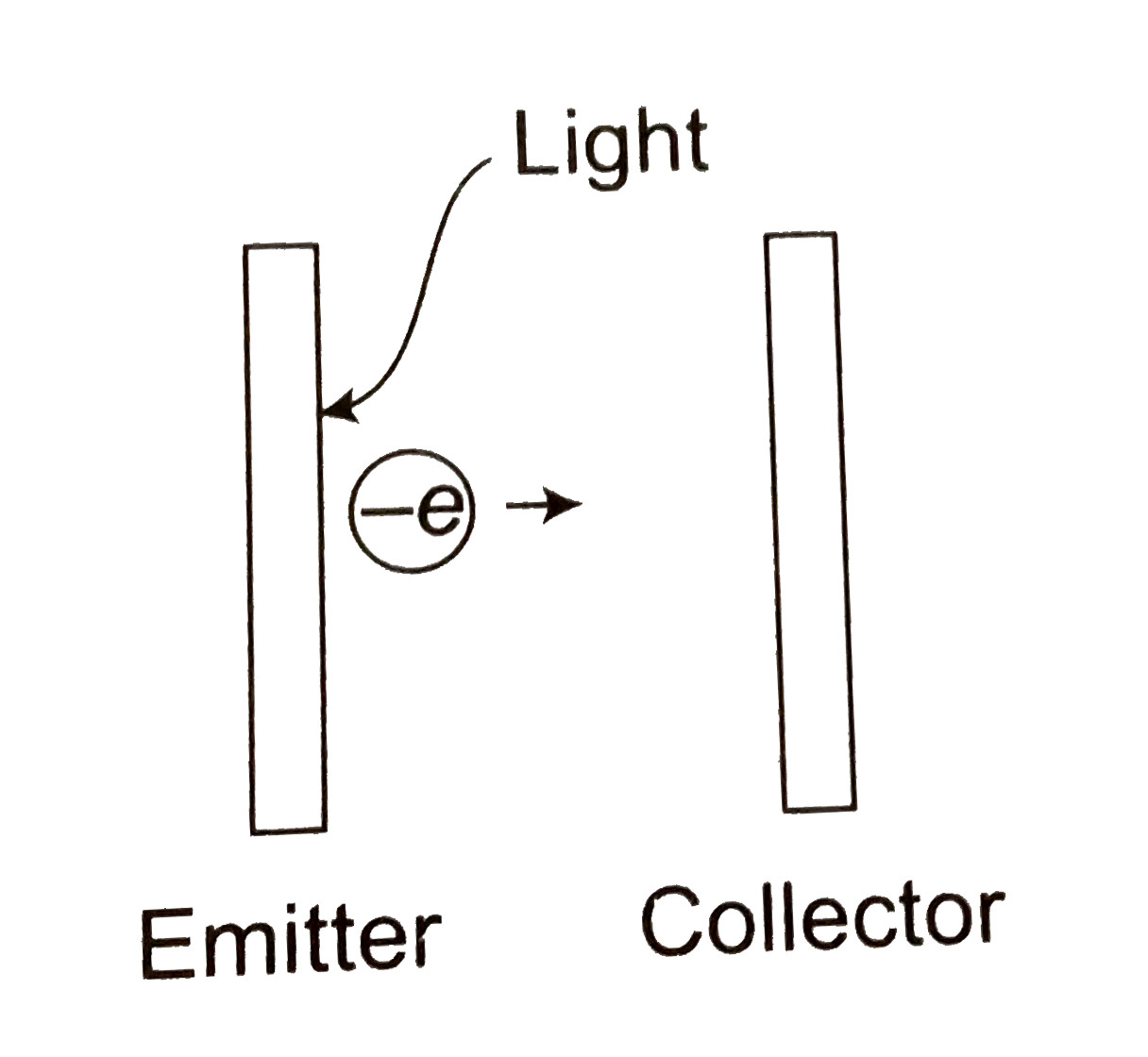(a) In a photoelectric experiment, the collector plate is at 2.0V with respect to the emitter plate made of copper (ϕ=4.5eV) . The emitter is illuminated by a source of monochromatic light of wavelength 200 nm. Find minimum and maximum kinetic energy of the photoelectrons reaching the collector.
(b) A small piece of cesium metal (ϕ=1.9eV) is kept a distance of 20 cm from a large metal plate having a charge density of 8.85×10−9C/m2 on the surface facing the cesium piece. A monochromatic light of wavelength 400 nm is incident on the cesium piece. Find minimum and the maximum kinetic energy of the photoelectrons reaching the large metal plate. Neglect any change in the electric field due to the presence of small piece of cesium.
(a) Energy of incident photon
E=1242λ(nm)eV=1242200=6.21eV
E=ϕ+Kmax
6.21=4.5+Kmax
Kmax=1.71eV

When electron reaches to collector plate, it is accelerated by potential 2 V.
Energy of electron emitted by emitter is as follows:
Kmin=0,Kmax=1.71eV
When electron reaches to collector its energy.
(i) 0+2=2eV=K'min
(ii) 1.71+2=3.71eV=K'max
(b) 
Incident energy of photon
E=1242λ(nm)=1242400=3.1eV
E=ϕ+Kmax
3.1=1.9+Kmax⇒Kmax=1.2eV
If electrons are emitted with zero velocity, Kmin=0

p.d.V=Ed=σ∈0d
=8.85×10−98.85×10−12×0.2=20V
Due to this potential, electron is accelerated towards large plate, energy gained by electron due to this p.d. = 20 eV
(i) 0+20=20eV=K'min
(ii) 1.2+20=21.2eV=K'max
Topper's Solved these Questions
Similar Questions
In a photoelectric experiment, the collector plate is at 2.0 V with respect to the emitter plate made of copper '(phi = 4.5)'. The emitter is illuminated by a source of monochromatic light of wavelength 200nm. Find the minimum and maximum kinetic energy of the photoelectrons reaching the collector.
View SolutionIn a photoelectric experiment, the collector plate is at 2.0 V with respect to the emitter plate made of copper ϕ=4.5. The emitter is illuminated by a source of monochromatic light of wavelength 200nm. Find the minimum and maximum kinetic energy of the photoelectrons reaching the collector.
View SolutionIn a photoelectric experiment, the collector plate is at 2.0V with respect to the emitter plate made of copper (ϕ)=4.5eV). The emitter is illuminated by a source of monochromatic light of wavelength 2000 Ånm.
View SolutionIn a photoelectric experiment, the collector plate is at 2.0V with respect to the emitter plate made of copper (ϕ)=4.5eV). The emitter is illuminated by a source of monochromatic light of wavelength 2000 Ånm.
View SolutionA small piece of cesium metal ϕ=1.9eV is kept at a distance of 20 cm form a large metal plate having a charge density of 1.0×10−9Cm−2 on the surface facing the cesium piece. A monochromatic light of wavelength 400nm is incident on the cesium piece. Find the minimum and the maximum kinetic energy of the photoelectrons reaching the large metal plate. Neglect any change in electric field due to the small piece of cesium present.
View SolutionA small piece of cesium metal is kept at a distance of 20 cm form a large metal plate having a charge density of 1.0×(10−9)C(m−2) on the surface facing the cesium piece. A monochromatic light of wavelength 400nm is incident on the cesium piece. Find the minimum and the maximum kinetic energy of the photoelectrons reaching the large metal plate. Neglect any change in electric field due to the small piece of cesium present.
View SolutionLight of wavelength 2000Å is incident on a metal surface of work function 3.0 eV. Find the minimum and maximum kinetic energy of the photoelectrons.
View SolutionLight of wavelength 2000Å is incident on a metal surface of work function 3.0 eV. Find the minimum and maximum kinetic energy of the photoelectrons.
View SolutionUltraviolet light of wavelength 280 nm is used in an
experiment on photoelectric effect with lithium
(φ=2.5eV) cathode. Find (a) the maximum kinetic
energy of the photoelectrons and (b) the stopping
potential.
View SolutionUltraviolet light of wavelength 280 nm is used in an experiment on photoelectric effect with lithium (φ=2.5eV) cathode. Find (a) the maximum kinetic energy of the photoelectrons and (b) the stopping potential.
View Solution

